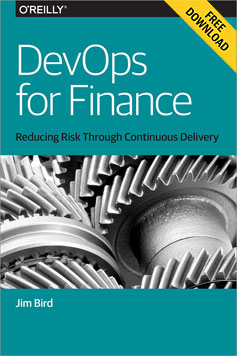- What Paul Graham is Missing About Inequality (Tim O’Reilly) — When a startup doesn’t have an underlying business model that will eventually produce real revenues and profits, and the only way for its founders to get rich is to sell to another company or to investors, you have to ask yourself whether that startup is really just a financial instrument, not that dissimilar to the CDOs of the 2008 financial crisis — a way of extracting value from the economy without actually creating it.
- 2016 The Year of Conversational Commerce (Chris Messina) — I really hope that these conversations with companies are better than the state-of-the-art delights of “press 5 to replay” phone hell.
- Society of Mind (MIT) — Marvin Minsky’s course, with lectures.
-
Trust vs Transparency (PDF) — explanation facilities
can potentially drop both a user’s confidence and make the process of search more stressful. Aka “few takers for sausage factory tours.” (via ACM Queue)
"finance" entries


Four short links: 26 January 2016
Inequality, Conversational Commerce, Minsky Lectures, and Trust vs Transparency

Is 2016 the year you let robots manage your money?
The O’Reilly Data Show podcast: Vasant Dhar on the race to build “big data machines” in financial investing.
Subscribe to the O’Reilly Data Show Podcast to explore the opportunities and techniques driving big data and data science.
In this episode of the O’Reilly Data Show, I sat down with Vasant Dhar, a professor at the Stern School of Business and Center for Data Science at NYU, founder of SCT Capital Management, and editor-in-chief of the Big Data Journal (full disclosure: I’m a member of the editorial board). We talked about the early days of AI and data mining, and recent applications of data science to financial investing and other domains.
Dhar’s first steps in applying machine learning to finance
I joke with people, I say, ‘When I first started looking at finance, the only thing I knew was that prices go up and down.’ It was only when I actually went to Morgan Stanley and took time off from academia that I learned about finance and financial markets. … What I really did in that initial experiment is I took all the trades, I appended them with information about the state of the market at the time, and then I cranked it through a genetic algorithm and a tree induction algorithm. … When I took it to the meeting, it generated a lot of really interesting discussion. … Of course, it took several months before we actually finally found the reasons for why I was observing what I was observing.

Continuous Delivery versus Continuous Deployment

Download DevOps for Finance.
The DevOps Audit Defense Toolkit tries to make a case to an auditor for Continuous Deployment in a regulated environment: that developers, following a consistent, disciplined process, can safely push changes out automatically to production once the changes pass all of the reviews and automated tests and checks in the CD pipeline.
Continuous Deployment has been made famous at places like Flickr, IMVU (where Eric Ries developed the ideas for the Lean Startup method), and Facebook:
Facebook developers are encouraged to push code often and quickly. Pushes are never delayed and [are] applied directly to parts of the infrastructure. The idea is to quickly find issues and their impacts on the rest of the system and surely [fix] any bugs that would result from these frequent small changes.1
While organizations like Etsy and Wealthfront work hard to make Continuous Deployment safe, it is scary to auditors, to operations managers, and to CTOs like me who have been working in financial technology and understand the risks involved in making changes to a live, business-critical system.
Continuous Deployment requires you to shut down a running application on a server or a virtual machine, load new code, and restart. This isn’t that much of a concern for stateless web applications with pooled connections, where browser users aren’t likely to notice that they’ve been switched to a new environment in Blue-Green deployment.2 There are well-known, proven techniques and patterns for doing this that you can follow with confidence for this kind of situation.

DevOps for Finance
How DevOps will help you surpass the common challenges of financial services software development.

Download DevOps for Finance.
Download a free copy of DevOps for Finance, an O’Reilly report by Jim Bird for the financial services software insider who’s heard about DevOps, but is unsure whether it represents solution or suicide.
DevOps, until recently, has been a story about unicorns. Innovative, engineering-driven online tech companies like Flickr, Etsy, Twitter, Facebook, and Google. Netflix and its Chaos Monkey. Amazon deploying thousands of changes per day.
DevOps was originally about WebOps at Internet companies working in the Cloud, and a handful of Lean Startups in Silicon Valley. It started at these companies because they had to move quickly, so they found new, simple, and collaborative ways of working that allowed them to innovate much faster and to scale much more effectively than organizations had done before.
But as the velocity of change in business continues to increase, enterprises — sometimes referred to as “horses,” in contrast to the unicorns referenced above — must also move to deliver content and features to customers just as quickly. These large organizations have started to adopt (and, along the way, adapt) DevOps ideas, practices, and tools.
This short book assumes that you have heard about DevOps and want to understand how DevOps practices like Continuous Delivery and Infrastructure as Code can be used to solve problems in financial systems at a trading firm, or a big bank or stock exchange. We’ll look at the following key ideas in DevOps, and how they fit into the world of financial systems:
- Breaking down the “wall of confusion” between development and operations, and extending Agile practices and values from development to operations
- Using automated configuration management tools like Chef, Puppet, CFEngine, or Ansible to programmatically provision and configure systems (Infrastructure as Code)
- Building Continuous Integration and Continuous Delivery (CI/CD) pipelines to automatically test and push out changes, and wiring security and compliance into these pipelines
- Using containerization and virtualization technologies like Docker and Vagrant, together with Infrastructure as Code, to create IaaS, PaaS, and SaaS clouds
- Running experiments, creating fast feedback loops, and learning from failure
To follow this book you need to understand a little about these ideas and practices. There is a lot of good stuff about DevOps out there, amid the hype. Read more…

Filing cabinets, GAAP, and the accountant’s dilemma
The inability to take advantage of digital technology is as big a threat to financial organizations as any fintech startup.
Learn more about Next:Money, O’Reilly’s conference focused on the fundamental transformation taking place in the finance industry.
 There’s plenty of news about the fintech, or financial technology, sector these days. Hundreds of nimble startups are disaggregating the age-old financial systems on which every transaction has relied for decades. There’s little doubt that this will continue — after all, more than four billion humans have a mobile phone, and 1.3 billion know how to use a Facebook feed, but only a billion are what we’d consider “normally banked.” Something’s got to give, and software is eating traditional financial systems one bite at a time.
There’s plenty of news about the fintech, or financial technology, sector these days. Hundreds of nimble startups are disaggregating the age-old financial systems on which every transaction has relied for decades. There’s little doubt that this will continue — after all, more than four billion humans have a mobile phone, and 1.3 billion know how to use a Facebook feed, but only a billion are what we’d consider “normally banked.” Something’s got to give, and software is eating traditional financial systems one bite at a time.
But the existing financial industry isn’t just under threat from outside. Many of the processes and institutions of finance have been around for centuries, and their processes are tied to physical systems rather than digital ones. As a result, they’re unable to take advantage of digital innovations easily and remain competitive. Read more…

9.3 trillion reasons fintech could change the developing world
Modern fintech is going to create formal, standard records about economies where none existed before.
Learn more about Next:Money, O’Reilly’s conference focused on the fundamental transformation taking place in the finance industry.
A relatively commonplace occurrence — credit card fraud — made me reconsider the long-term impact of financial technology outside the Western world. I’ll get to it, but first, we need to talk about developing economies.
I’m halfway through Hernand de Soto’s The Mystery of Capital on the advice of the WSJ’s Michael Casey. Its core argument is that capitalism succeeds in the Western world and fails everywhere else because in the West, property can be turned into capital (you can mortgage a house and use that money to do something). The book uses the analogy of a hydroelectric dam as a means of unlocking the hidden, potential value of the lake.
But in much of the world, it is unclear who owns what, and as a result, the value of assets can’t be put to work in markets. In the West, we take concepts like title and lien and identity for granted; yet, these systems are relatively new and don’t exist around the world. As de Soto noted in his book, in the Soviet Union, unofficial economic activity rose from 12% in 1989 to 37% in 1994. Read more…

Here’s why finance is about to be disrupted
O'Reilly's Next:Money event helps business leaders understand the fundamental shifts reshaping finance.

Learn more about Next:Money, O’Reilly’s conference focused on the fundamental transformation taking place in the finance industry.
Editor’s note: We’re approaching an inflection point in all things “money” — currency, transactions, markets, and capitalism itself. Fundamental changes in the financial industry, driven by technology but with implications for every business and government, are beginning to manifest, bringing both disruption and opportunity. We created O’Reilly’s new conference, Next:Money to help business leaders understand and act on this shift. Below, investor and entrepreneur Paul Kedrosky lays out the forces and patterns that are reshaping the financial industry.
Finance has the three main characteristics of an industry likely to be transformed by technology:
- It traffics in bits, not atoms.
- Its services are often delivered remotely.
- There is little need for human contact.
Unlike other sectors with these characteristics — e.g., media, advertising, and travel services — finance hasn’t been disrupted. Despite huge technological change and a series of financial crises, the league table of the largest financial firms today, both in the U.S. and around the world, remains much the same as it has always been.
Granted, the $1.2-trillion U.S. financial services industry isn’t homogenous. Its main components — banks, brokers, asset managers, markets, payment networks, insurers, and credit card companies — are very different, and have seen widely varying degrees of technology-induced change. In no sense, however, is this industry as transformed by new companies and new business models as one would expect, given its disruption-ready characteristics.
So, why haven’t entrepreneurs transformed finance? There are (at least) five reasons: Read more…

Data science makes an impact on Wall Street
The O'Reilly Data Show Podcast: Gary Kazantsev on how big data and data science are making a difference in finance.
Learn more about Next:Money, O’Reilly’s conference focused on the fundamental transformation taking place in the finance industry.
 Having started my career in industry, working on problems in finance, I’ve always appreciated how challenging it is to build consistently profitable systems in this extremely competitive domain. When I served as quant at a hedge fund in the late 1990s and early 2000s, I worked primarily with price data (time-series). I quickly found that it was difficult to find and sustain profitable trading strategies that leveraged data sources that everyone else in the industry examined exhaustively. In the early-to-mid 2000s the hedge fund industry began incorporating many more data sources, and today you’re likely to find many finance industry professionals at big data and data science events like Strata + Hadoop World.
Having started my career in industry, working on problems in finance, I’ve always appreciated how challenging it is to build consistently profitable systems in this extremely competitive domain. When I served as quant at a hedge fund in the late 1990s and early 2000s, I worked primarily with price data (time-series). I quickly found that it was difficult to find and sustain profitable trading strategies that leveraged data sources that everyone else in the industry examined exhaustively. In the early-to-mid 2000s the hedge fund industry began incorporating many more data sources, and today you’re likely to find many finance industry professionals at big data and data science events like Strata + Hadoop World.
During the latest episode of the O’Reilly Data Show Podcast, I had a great conversation with one of the leading data scientists in finance: Gary Kazantsev runs the R&D Machine Learning group at Bloomberg LP. As a former quant, I wanted to know the types of problems Kazantsev and his group work on, and the tools and techniques they’ve found useful. We also talked about data science, data engineering, and recruiting data professionals for Wall Street. Read more…


Four short links: 27 January 2015
Autonomous Corporations, Abstract Thought, Down Rounds, and Distributed Messaging
- Decentralised Autonomous Corporations — Charlie Stross’s near-future fiction of Accelerando comes closer to reality: Malice – revenge for waking him up – sharpens Manfred’s voice. “The president of agalmic.holdings.root.184.97.AB5 is agalmic.holdings.root.184.97.201. The secretary is agalmic.holdings.root.184.D5, and the chair is agalmic.holdings.root.184.E8.FF. All the shares are owned by those companies in equal measure, and I can tell you that their regulations are written in Python. Have a nice day, now!” He thumps the bedside phone control and sits up, yawning, then pushes the do-not-disturb button before it can interrupt again. After a moment he stands up and stretches, then heads to the bathroom to brush his teeth, comb his hair, and figure out where the lawsuit originated and how a human being managed to get far enough through his web of robot companies to bug him.
- Coding is Not the New Literacy (Chris Grainger) — We build mental models of everything – from how to tie our shoes to the way macro-economic systems work. With these, we make decisions, predictions, and understand our experiences. If we want computers to be able to compute for us, then we have to accurately extract these models from our heads and record them. Writing Python isn’t the fundamental skill we need to teach people. Modeling systems is. Amen!
- Let’s Stop Laughing at Groupon (Fortune) — it is much easier to survive a valuation decline as a public company than as a private one.
- nsq — Bitly’s open sourced realtime distributed messaging platform.

